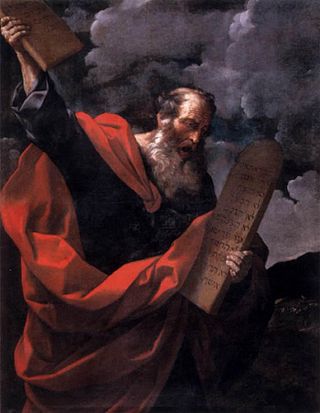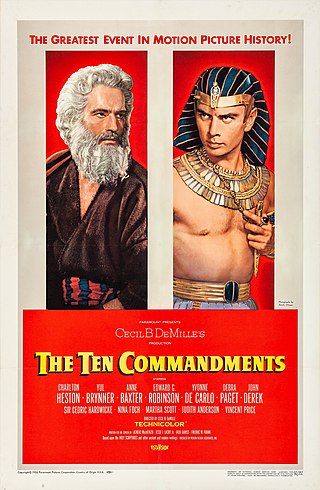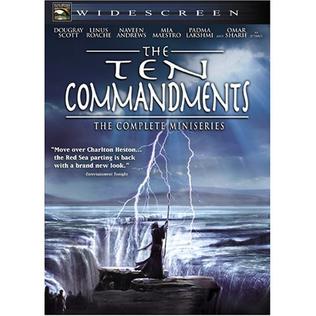
The Book of Exodus is the second book of the Bible. It narrates the story of the Exodus, in which the Israelites leave slavery in Biblical Egypt through the strength of Yahweh, who has chosen them as his people. The Israelites then journey with the prophet Moses to Mount Sinai, where Yahweh gives the 10 commandments and they enter into a covenant with Yahweh, who promises to make them a "holy nation, and a kingdom of priests" on condition of their faithfulness. He gives them their laws and instructions to build the Tabernacle, the means by which he will come from heaven and dwell with them and lead them in a holy war to possess the land of Canaan, which had earlier, according to the story of Genesis, been promised to the seed of Abraham.

Moses is considered the most important prophet in Judaism and one of the most important prophets in Christianity, Islam, the Druze faith, the Baháʼí Faith and other Abrahamic religions. According to both the Bible and the Quran, Moses was the leader of the Israelites and lawgiver to whom the authorship, or "acquisition from heaven", of the Torah is attributed.

The Ten Commandments is a 1956 American epic religious drama film produced, directed, and narrated by Cecil B. DeMille, shot in VistaVision, and released by Paramount Pictures. The film is based on the 1949 novel Prince of Egypt by Dorothy Clarke Wilson, the 1859 novel Pillar of Fire by J. H. Ingraham, the 1937 novel On Eagle's Wings by A. E. Southon, and the Book of Exodus, found in the Holy Bible. The Ten Commandments dramatizes the biblical story of the life of Moses, an adopted Egyptian prince who becomes the deliverer of his real brethren, the enslaved Hebrews, and thereafter leads the Exodus to Mount Sinai, where he receives, from God, the Ten Commandments. The film stars Charlton Heston in the lead role, Yul Brynner as Rameses, Anne Baxter as Nefretiri, Edward G. Robinson as Dathan, Yvonne De Carlo as Sephora, Debra Paget as Lilia, and John Derek as Joshua; and features Sir Cedric Hardwicke as Seti I, Nina Foch as Bithiah, Martha Scott as Yochabel, Judith Anderson as Memnet, and Vincent Price as Baka, among others.
According to Jewish tradition, the Torah contains 613 commandments. This tradition is first recorded in the 3rd century CE, when Rabbi Simlai mentioned it in a sermon that is recorded in Talmud Makkot 23b. Other classical sages who hold this view include Rabbi Simeon ben Azzai and Rabbi Eleazar ben Yose the Galilean. It is quoted in Midrash Shemot Rabbah 33:7, Bamidbar Rabbah 13:15–16; 18:21 and Talmud Yevamot 47b. The 613 commandments include "positive commandments", to perform an act, and "negative commandments", to abstain from an act. The negative commandments number 365, which coincides with the number of days in the solar year, and the positive commandments number 248, a number ascribed to the number of bones and main organs in the human body.
Antinomianism is any view which rejects laws or legalism and argues against moral, religious or social norms, or is at least considered to do so. The term has both religious and secular meanings.
In its primary meaning, the Hebrew word mitzvah refers to a commandment commanded by God to be performed as a religious duty. Jewish law in large part consists of discussion of these commandments. According to religious tradition, there are 613 such commandments.

According to the Bible, Jochebed was a daughter of Levi and mother of Miriam, Aaron and Moses. She was the wife of Amram, as well as his aunt. No details are given concerning her life. According to Jewish legend, she is buried in the Tomb of the Matriarchs, in Tiberias. In the New Testament, she is praised for her faith in God.

Moses is a sculpture by the Italian High Renaissance artist Michelangelo Buonarroti, housed in the church of San Pietro in Vincoli in Rome. Commissioned in 1505 by Pope Julius II for his tomb, it depicts the biblical figure Moses with horns on his head, based on a description in chapter 34 of Exodus in the Vulgate, the Latin translation of the Bible used at that time.

The Law of Moses, also called the Mosaic Law, primarily refers to the Torah or the first five books of the Hebrew Bible. It is the law revealed to Moses by God.

The Exodus is the founding myth of the Israelites whose narrative is spread over four books of the Torah, namely Exodus, Leviticus, Numbers, and Deuteronomy. The majority of modern scholars date the composition of the Torah to the Middle Persian Period. Some of the traditions contributing to this narrative are older, since allusions to the story are made by 8th-century BCE prophets such as Amos and Hosea.

The Ritual Decalogue is a list of laws at Exodus 34:11–26. These laws are similar to the Covenant Code and are followed by the phrase "ten commandments". Although the phrase "Ten Commandments" has traditionally been interpreted as referring to a very different set of laws, in Exodus 20:2–17, many scholars believe it instead refers to the Ritual Decalogue found two verses earlier.

The Ten Commandments, or the Decalogue, are a set of biblical principles relating to ethics and worship that play a fundamental role in Judaism and Christianity. The text of the Ten Commandments appears twice in the Hebrew Bible: at Exodus 20:2–17 and Deuteronomy 5:6–21.

The Ten Commandments is a 1923 American silent religious epic film produced and directed by Cecil B. DeMille. Written by Jeanie MacPherson, the film is divided into two parts: a prologue recreating the biblical story of the Exodus and a modern story concerning two brothers and their respective views of the Ten Commandments.

The Pharaoh's daughter in the story of the finding of Moses in the biblical Book of Exodus is an important, albeit minor, figure in Abrahamic religions. Though some variations of her story exist, the general consensus among Jews, Christians, and Muslims is that she is the adoptive mother of the prophet Moses. Muslims identify her with Asiya, the Great Royal Wife of the pharaoh. In either version, she saved Moses from certain death from both the Nile river and from the Pharaoh. As she ensured the well-being of Moses throughout his early life, she played an essential role in lifting the Hebrew slaves out of bondage in Egypt, their journey to the Promised Land, and the establishment of the Ten Commandments.

The Ten Commandments is a 2006 miniseries that dramatizes the biblical story of Moses. It ran on the ABC TV network.

Mosaic authorship is the Judeo-Christian tradition that the Torah, the first five books of the Hebrew Bible/Old Testament, were dictated by God to Moses. The tradition probably began with the legalistic code of the Book of Deuteronomy and was then gradually extended until Moses, as the central character, came to be regarded not just as the mediator of law but as author of both laws and narrative.
Benny Shanon is an emeriti professor of psychology at the Hebrew University of Jerusalem and holds the Mandel Chair in cognitive psychology and education. Born in Tel Aviv, Shanon studied philosophy and linguistics at Tel Aviv University and received his doctorate in experimental psychology from Stanford University. He is best known for the Biblical entheogen hypothesis, the idea that the use of hallucinogenic drugs influenced religion.

The Ten Commandments is a 2007 computer-animated biblical epic film directed by John Stronach and Bill Boyce. The film was released by Promenade Pictures. The film follows Moses from his childhood, as the adopted grandson of Pharaoh, to his adulthood, as the chosen one of Yahweh and liberator of his people.

The Ten Commandments: The Musical is a musical with music by Patrick Leonard and lyrics by Maribeth Derry. The book is adapted from the French musical Les Dix Commandements created by Élie Chouraqui from an idea by Albert Cohen, which in turn was based on the Book of Exodus and the 1956 epic film The Ten Commandments.

"Finger of God" is a phrase used in the Torah, translated into the Christian Bible. In Exodus 8:16–20 it is used during the plagues of Egypt by the Egyptian magicians. In Exodus 31:18 and Deuteronomy 9:10 it refers to the method by which the Ten Commandments were written on tablets of stone that were brought down from Mount Sinai by Moses.













